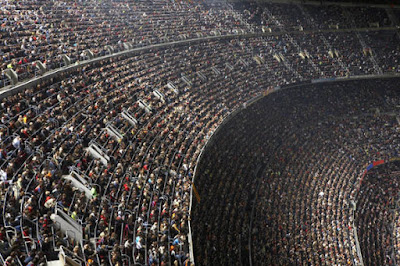Rain of FISH
Every year for the past 100 years or so, the little city of Yoro, Honduras, has experienced some very strange weather.
Typically occurring in May or June, "lluvia de peces" or "rain of fish" is an annual weather event in which hundreds of fish rain from the sky onto the city's streets in the wake of severe thunderstorms.
"Fish rain" or "animal rain," as the phenomenon is commonly known, has been reported around the world for centuries. But scientific explanations for why the phenomenon occurs are few and far between.
One hypothesis suggests that a fish-rain such as lluvia de peces originates with waterspouts, which are tornadoes that move over water, sucking up small creatures living below the surface — usually fish and frogs — and depositing them elsewhere.
However, waterspouts are not known to carry their aquatic cargo great distances. This doesn't help explain Yoro's fishy weather, because the fish that end up stranded there are not indigenous to local rivers or streams.
If the waterspout theory were correct, then Yoro's fish would have to come from the next-closest body of water — the Atlantic Ocean — and that's about 125 miles (200 kilometers) away.
Local legend has it that the lluvia de peces event is actually a blessing bestowed upon the people of Yoro by Father Jose Manuel Subirana, a Spanish missionary who visited the area in the 1860s and prayed for the region's poor and hungry, asking God to provide them with food.
Perhaps the most likely theory to explain the lluvia de peces phenomenon is the one proposed by a team of National Geographic scientists, who witnessed this bizarre event while on assignment in Yoro in the 1970s.
After noting that the washed-up fish were completely blind, the scientists concluded that the Yoro fish don't actually fall from the sky. Instead, the heavy rains preceding their appearance probably force these subterranean fish above ground.
While this theory of the lluvia de peces makes the most sense, it's also the least romantic, and is therefore largely ignored.
پچھلے 100 سالوں سے ہر سال ، چھوٹے شہر یورو ، ہونڈوراس ، نے کچھ نہایت ہی عجیب و غریب موسم کا سامنا کیا ہے۔
عام طور پر مئی یا جون میں ہونے والا ، "لیوویا ڈی پیس" یا "مچھلی کی بارش" موسمی موسم کا ایک ایسا واقعہ ہے جس میں طوفانی طوفان کے بعد سیکڑوں مچھلی آسمان سے شہر کی سڑکوں پر آتی ہے۔
"مچھلی کی بارش" یا "جانوروں کی بارش" ، جیسا کہ اس رجحان کو عام طور پر جانا جاتا ہے ، دنیا بھر میں صدیوں سے اس کی اطلاع دی جارہی ہے۔ لیکن اس رجحان کی وجہ سے سائنسی وضاحتیں بہت کم اور دور ہیں۔
ایک مفروضے سے پتہ چلتا ہے کہ مچھلی کی بارش جیسے لولویا ڈی پیسس کی ابتدا واٹرباؤٹس سے ہوتی ہے ، جو بگولے ہوتے ہیں جو پانی کے اوپر منتقل ہوتے ہیں ، سطح کے نیچے رہنے والی چھوٹی مخلوقات - عام طور پر مچھلی اور مینڈک کو چوس لیتے ہیں اور کہیں اور جمع کرتے ہیں۔
تاہم ، واٹر سپاوٹس اپنے آبی کارگو کو بہت فاصلے تک نہیں رکھتے ہیں۔ اس سے یورو کے مچھلی والے موسم کی وضاحت کرنے میں مدد نہیں ملتی ہے ، کیونکہ مچھلی جو وہاں پھنس کر رہ جاتی ہیں وہ مقامی دریاؤں یا نہروں سے دیسی نہیں ہیں۔
اگر واٹر سپاٹ کا نظریہ درست تھا تو ، یورو کی مچھلی کو پانی کے اگلے قریب ترین پانی یعنی بحر اوقیانوس سے آنا پڑتا تھا - اور یہ تقریبا 125 125 میل (200 کلومیٹر) دور ہے۔
مقامی لیجنڈ کے مطابق یہ حقیقت ہے کہ لولویا ڈی پیس واقعہ یورو کے لوگوں کو ایک ہسپانوی مشنری فادر جوس مانوئل سبیرینہ نے عطا کیا ہے ، جو 1860 کی دہائی میں اس علاقے کا دورہ کیا اور اس خطے کے غریب اور بھوکے لوگوں کے لئے دعا کی ، خدا سے دعا کی کہ وہ ان کو مہیا کرے۔ کھانے کے ساتھ.
لیویا ڈی پیسیس رجحان کی وضاحت کرنے کا سب سے زیادہ امکان والا نظریہ نیشنل جیوگرافک سائنسدانوں کی ایک ٹیم نے تجویز کیا تھا ، جس نے 1970 کی دہائی میں یورو میں تقرری کے دوران اس عجیب واقعے کا مشاہدہ کیا تھا۔
یہ نوٹ کرنے کے بعد کہ نہلایا ہوا مچھلی مکمل طور پر اندھی تھی ، سائنس دانوں نے یہ نتیجہ اخذ کیا کہ یورو مچھلی حقیقت میں آسمان سے نہیں گرتی ہے۔ اس کے بجائے ، ان کی ظاہری شکل سے قبل ہونے والی موسلا دھار بارشیں شاید ان مٹی مچھلیوں کو زمین کے اوپر مجبور کردیں۔
اگرچہ لولویا ڈی پیرس کا یہ نظریہ سب سے زیادہ معنی خیز ہے ، یہ کم تر رومانٹک بھی ہے ، اور اسی وجہ سے بڑے پیمانے پر نظرانداز کیا جاتا ہے۔









Comments
Post a Comment